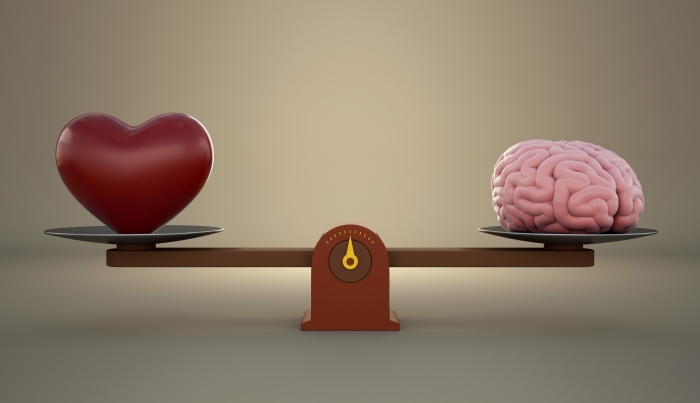This month, we’ve been talking about love—one of, if not the most, powerful forces driving human behavior. In the world of psychotherapy we know that love can bring great joy, but it can also be the cause of immense pain and suffering. As the authors of ACT & RFT in Relationships point out early in their book, much of the research done in hopes of better understanding love has been focused on neurological phenomena. Today, we’re taking a look at some of this research.
Neuroimaging of people experiencing passionate love, for example, has shown activation in subcortical areas associated with emotions, rewards, and motivation as well as cortical areas related to memory, attention, social cognition, and other higher-order brain functions (Aron et al., 2005; Cacioppo, Bianchi-Demicheli, Hatfield, & Rapson, 2012; Fisher, Aron, & Brown, 2006; Schneiderman, Zagoory-Sharon, Leckman, & Feldman, 2012). As anyone experiencing intense love can attest, the high level of subcortical activity in dopaminergic areas is similar to drug-induced euphoria (Acevedo, Aron, Fisher, & Brown, 2012).
When in love, people feel “high” and “on top of the world.” Research has even suggested that being in love can attenuate the cravings associated with withdrawal from addictive substances (Xu et al., 2012). Activation in these reward-related areas of the brain, as well as areas indicative of attachment and pair-bonding, can continue even over long-term relationships.
Researchers have also found that the breakup of a romantic relationship can cause activity in brain regions associated with physical pain, thus giving credence to the popular maxim that love hurts (Kross, Berman, Mischel, Smith, & Wager, 2011). Taken together, these neurological studies of passionate love reveal that it activates brain areas associated with feelings, senses, and cognitions (Ortigue, Bianchi-Demicheli, Patel, Frum, & Lewis, 2010). As such, it provides some evidence for Lao-tzu’s observation “Love is of all passions the strongest, for it attacks simultaneously the head, the heart, and the senses” (Lao-tzu, n.d.)
Most studies of the physical effects of love have examined people in long-term relationships. For example, one oft-quoted statistic is that being in a good marriage promotes longevity: compared to unmarried people of the same gender, married men live about seven years longer, and married women live about three years longer (Parker-Pope, 2010). Conversely, the death of a spouse is considered one of the most stressful life experiences (Holmes & Rahe, 1967). Though these findings are intriguing, the degree to which they relate to love is unclear. For example, increased longevity might be related to partners taking care of each other and better caring for themselves.
We just love talking about love. So next week, we’ll be back with more from the authors of ACT & RFT in Relationships. We’ll be looking at styles of love, and the particular ways people experience love. Stay tuned!
References
Acevedo, B. P., Aron, A., Fisher, H. E., & Brown, L. L. (2012). Neural correlates of long-term intense romantic love. Social Cognitive and Affective Neuroscience, 7(2), 145–159.
Aron, A., Fisher, H., Mashek, D. J., Strong, G., Li, H., & Brown, L. L. (2005). Reward, motivation, and emotion systems associated with early-stage intense romantic love. Journal of Neurophysiology, 94(1), 327–337.
Cacioppo, S., Bianchi-Demicheli, F., Hatfield, E., & Rapson, R. L. (2012). Social neuroscience of love. Clinical Neuropsychiatry: Journal of Treatment Evaluation, 9(1), 3–13.
Fisher, H., Aron, A., & Brown, L. L. (2005). Romantic love: An fMRI study of a neural mechanism for mate choice. Journal of Comparative Neurology, 493, 58–62.
Holmes, T. H., & Rahe, R. H. (1967). The social readjustment rating scale. Journal of Psychosomatic Research, 11(2), 213–218.
Kross, E., Berman, M. G., Mischel, W., Smith, E. E., & Wager, T. D. (2011). Social rejection shares somatosensory representations with physical pain. Proceedings of the National Academy of Sciences, USA, 108, 6270–6275.
Lao-tzu. (n.d.). Love is of all passions the strongest, for it attacks simultaneously the head, the heart… – Lao Tzu at Brainy Quote. Retrieved from http://www.brainyquote.com/quotes/quotes/l/laotzu387058.Html
Parker-Pope, T. (2010). For better: The science of a good marriage. New York: Dutton.
Schneiderman, I., Zagoory-Sharon, O., Leckman, J. F., & Feldman, R. (2012). Oxytocin during the initial stages of romantic attachment: Relations to couples’ interactive reciprocity. Psychoneuroendocrinology, 37, 1277–1285.
Ortigue, S., Bianchi-Demicheli, F., Patel, N., Frum, C., & Lewis, J. W. (2010). Neuroimaging of love: fMRI meta-analysis evidence toward new perspectives in sexual medicine. Journal of Sexual Medicine, 7, 3541–3552.
Xu, X., Wang, J., Aron, A., Lei, W., Westmaas, J. L., & Weng, X. (2012). Intense passionate love attenuates cigarette cue-reactivity in nicotine deprived smokers: An fMRI study. PLoS ONE, 7(7), e42235.doi:10.1371/journal.pone.0042235


 2024 Peace Playbook: 3 Tactics to Avoid Clashes with Your Partner
2024 Peace Playbook: 3 Tactics to Avoid Clashes with Your Partner